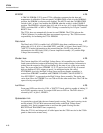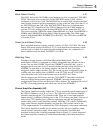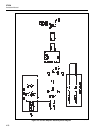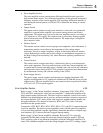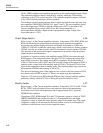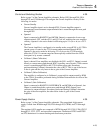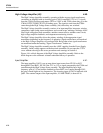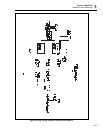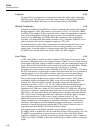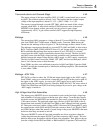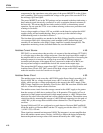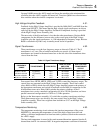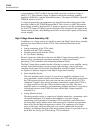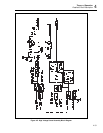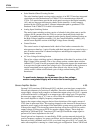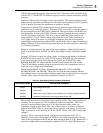
5725A
Instruction Manual
4-26
Integrator 4-42.
Op amp U601A is configured as an integrator to reduce the output offset of the input
amplifier circuit. This integrator senses the output voltage of the amplifier (MVOUT)
through R604 and R605 and forces it to be zero with respect to HVCOMM.
Window Comparator 4-43.
Comparators U604A and U604B form a window comparator that monitors the output of
the input amplifier, U602. The window is set to about +2.2V to +9V by R626, VR602,
and R636. If the output of U602 exceeds the window limits, the appropriate comparator
turns on the clamp, Q604, shorting the input to ground. The comparator also pulls
control line CLAMPS high via U604D, where the comparator routes to the Digital
Assembly (A5) through the Interconnect assembly (A1). Comparator U604D is a level
shifter to translate the window comparator output to a TTL level.
Exceeding the limits of the window comparator is an indication that the loop is in an
abnormal condition when the instrument is in the ac voltage standby or ac voltage
operate states. In current standby or current operate states, the comparator causes
CLAMPS to be asserted, which turns off the +400V and -400V supplies.
Input Clamp 4-44.
A FET clamp, Q604, is turned on until the output of U602 returns to the region within
the window. When this occurs, the comparator turns off Q603. To avoid a large transient
at the output of the High Voltage Amplifier assembly (A6), the clamp must be turned off
slowly. Resistor R637 and C618 slow the clamp drive signal to accomplish this. Though
Q604 can be turned off slowly by removing its gate drive slowly, it clamps
asymmetrically in the transition region. The body of the FET is held at -7.5V. This keeps
the FET from turning on at the negative peaks of the input waveform. The asymmetrical
clamping appears as a dc shift in the waveform, which can cause the transformer to
saturate. To alleviate this problem, a second clamp is placed in parallel with Q604.
This second clamp is the photoresistor portion of the optical isolator, U605. It has a
considerably higher on resistance than Q604, so the two are used together. When the
clamp is to be turned off, Q603 is turned off and the voltage on C618 begins its
transition from nearly +15V to -15V. At +15V, Q604 is turned on but because Q605 is
also on, shunting current from the input of U605, the photoresistor is in the high
impedance state. When the voltage on C618 reaches about +9V, Q605 turns off and the
optoisolator is turned on, putting the photoresistor into its low resistance state. This has
little effect on the input signal because the photoresistor is a higher impedance than the
FET. As the control voltage approaches zero, Q604 turns off and the input is clamped
only by the photoresistor. As the control voltage continues toward -15V, the
photoresistor makes the transition to its off, or high impedance state. The photoresistor
clamps symmetrically, eliminating the dc transient on the input. A similar transition
takes place when light turns on the clamp but it happens much faster, as the turn-on
transition is controlled by the time constant R631*C618 which is about an order of
magnitude faster than the R637*C618 turn-off time constant.
The microprocessor on the Digital assembly can also pull the clamp via control line
CLAMPD, which is latched into a driver on the High Voltage Sense assembly (A6). Line
CLAMPD is asserted during a sequenced turn on, power down of the High Voltage
Amplifier assembly (A3), or during a transition to another frequency range. Comparator
U604C level shifts CLAMPD and provides an OR function with the window comparator
output.



